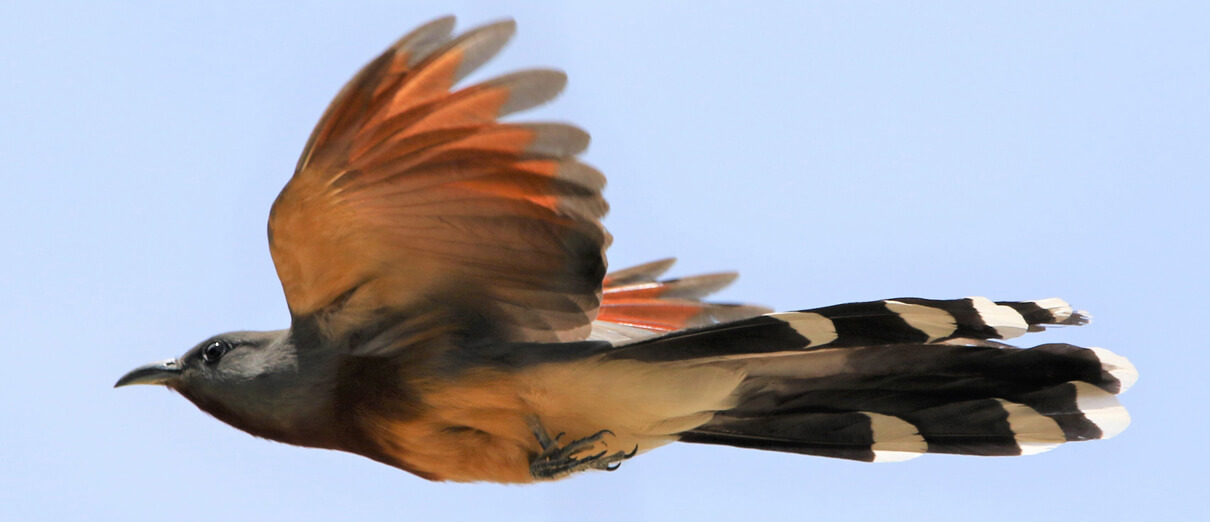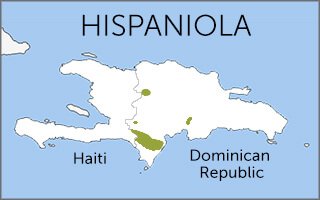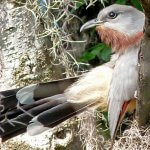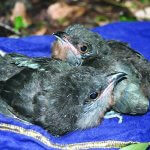About the Bay-breasted Cuckoo
In the Dominican Republic, the handsome Bay-breasted Cuckoo is a rare and sought-after sighting. Endemic to the Caribbean island of Hispaniola, this large cuckoo was once also found in Haiti. A glimpse of this elusive bird, usually through gaps in dense foliage, reveals its slate-colored upperparts, rich chestnut-colored breast, throat, and wing patch, and a long, black-and-white-spotted tail. Also notable is this bird's rather heavy, decurved bill, handy for plucking prey from branches.
Like other birds of its family, including the Yellow-billed Cuckoo, the Bay-breasted Cuckoo is a skulker that can be very hard to find in the tree canopy. It is most easily located by its very odd calls, which inspired some interesting local nicknames. What are some of these colorful monikers?
Goat Cuckoo
The most typical call of the Bay-breasted Cuckoo is a frog-like, repeated, and often accelerating “cúa,” which led to the bird being given this Spanish nickname. It also gives an assortment of other calls, including a goat-like bleating, which is the source of its Haitian name: “Takó Kabrit,” or “Goat Cuckoo.”
Songs and Sounds
Listen to the Bay-breasted Cuckoo's eponymous cúa call and odd bleating calls here:
Breeding and Feeding
The Bay-breasted Cuckoo has a short nesting season, which appears to coincide with the onset of the wet season in Hispaniola, and the ensuing abundance of insects, particularly cicadas, that hatch after the rains. Like the Mourning Dove, this cuckoo builds a platform-like loose stick nest, where the female lays two to three eggs. The nest is usually 10 to 20 feet above ground, concealed within a thick clump of vegetation.

Studies have shown that the Bay-breasted Cuckoo feeds heavily on lizards, but also takes insects and small rodents. It forages by moving stealthily from branch to branch in the mid- to upper story of the forest canopy, plucking food items from the vegetation. Cicadas are one of the main food sources that parents feed to their nestlings.
Region and Range

The Bay-breasted Cuckoo is currently found only in four protected areas in the Dominican Republic, with the majority of records in Sierra de Bahoruco National Park, a place it shares with other threatened birds including the White-fronted Quail-Dove, Black-capped Petrel, Hispaniolan Trogon, and Bicknell's Thrush. It's also known from Loma Charco Azul Biological Reserve, and Sierra de Neiba, and Nalga de Maco National Parks.
This species was once more widespread across central Hispaniola as well as on Gonâve, a Haitian island located west of Port-au-Prince.
Conservation of the Bay-breasted Cuckoo
The Bay-breasted Cuckoo has suffered a drastic decline in range and numbers due to unchecked deforestation for agriculture, grazing, and charcoal production. Unfortunately, inadequate protected area enforcement has allowed continued deforestation of its habitat, although the situation is starting to improve. In some areas, this rare bird is also hunted, due to traditional beliefs that its flesh provides certain health benefits.

Help support ABC's conservation mission!
ABC and partners including SOH Conservación, Fundación Loma Quita Espuela, and Grupo Jaragua continue work to preserve and protect habitat in the Dominican Republic. ABC has helped SOH improve habitat protection in Sierra de Bahoruco National Park, Bosque de las Nubes Reserve, and Domingo Fuertes National Monument, and supported the creation of the Loma Charco Azul Biological Reserve.
Get Involved
Many of the rarest bird species in the Western Hemisphere remain relatively unknown. You can learn more about these birds and the threats they face by signing up for ABC's Bird of the Week email series, which frequently highlights these fascinating birds.
American Bird Conservancy and our partners throughout Latin America and the Caribbean have created and expanded more than 100 bird reserves, which protect upward of 1.1 million acres of vital habitat. Together, we've planted more than 6.8 million trees, helping to restore degraded and damaged habitat. You can help us continue to protect endangered birds by making a gift today.





















































